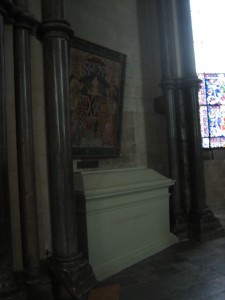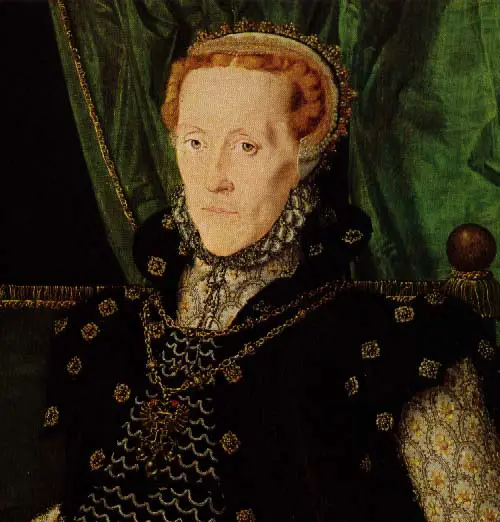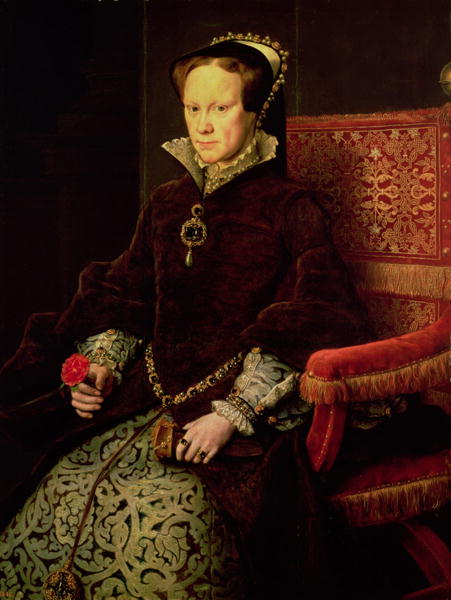
Cardinal Pole
Cardinal Pole died on the very same day as his beloved queen, Mary I. Raphael Holinshed's Chronicles record his death:
Leauing queene Marie being dead & gone, you are to vnderstand and note, that the same euening, or (as some haue written) the next daie after the said queens death,The death of [...]rdinall Poole. Cardinall Poole the bishop of Romes legat departed out of this life, hauing beene not long afore made archbishop of Canturburie: he died at his house ouer against Westminster commonlie called Lambe [...]h, and was buried in Christs church at Can|turburie.
The Chronicles go on to give a not so flattering account of Cardinal Pole's life, accusing him of "barbarous" behaviour and blemishing "the honour of his descent. You can read this account in the 1587 version of The Chronicles at The Holinshed Project.
Diarist and merchant Henry Machyn records how Cardinal Pole's remains were taken on 10th December from Lambeth to Canterbury in preparation for his burial:
The sam mornyng my lord cardenall was [removed from] Lambeth, and cared toward Canturbery with grett [company in] blake; and he was cared in a charett with [banner-]rolles wroth [wrought] with fyne gold and grett baners [of arms,] and iiij baners of santes in owllo [oil].
In Ecclesiastical Memorials, John Strype writes:
Cardinal Pole died the same day that Queen Mary did; and not many hours after her. His last will may be seen in Holinshed's History. Therein he desired his successor would not sue his executors for dilapidations, seeing he had bestowed more than a thousand pounds within these few years in repairing and making such houses as belonged to the see, since he came to it. The overseers of his will were Nicholas Archbishop of York, lord chancellor; Thomas Bishop of Ely; Ed. Lord Hastings, lord chamberlain; Sir John Boxal, the Queen's secretary; Sir Edward Cordal, master of the rolls; Henry Cole, vicar general of the spiritualities.
Strype goes on to describe how there was "a secret report among Papists, abroad soon after, that both Queen Mary and Cardinal Pole, came to their ends by poison but that Dr. Haddon, "a knowing man", put their deaths down to "an infectious fever that the nation then laboured under [...] an outrageous burning fever [...]".

Notes and Sources
Images: Cardinal Reginald Pole, Archbishop of Canterbury, by Sebastian del Piombo, and tomb of Cardinal Reginald Pole from Wikimedia Commons.
- Britton, John (1836) Cathedral Antiquities: Historical and Descriptive Accounts, with 311 Illustration, of the Following English Cathedrals...
- Holinshed's Chronicles of England, Scotland, and Ireland, 1587 edition, The Holinshed Project.
- 'Diary: 1558 (Aug - Dec)', in The Diary of Henry Machyn Citizen and Merchant-Taylor of London (1550-1563), ed. J G Nichols (London, 1848), pp. 169-184 http://www.british-history.ac.uk/camden-record-soc/vol42/pp169-184 [accessed 10 December 2015].
- Strype, John (1822) Ecclesiastical memorials; relating chiefly to religion, and the reformation of it..., p. 143. This can be read on Google Books.



Of course it was poison, it was always poison, every mysteries or contagion or long illness was poison. lol. Edward iv was poisoned, even though he died from bad fish and a bout of pneumonia. Anne Neville was poisoned even though she died from consumption after being ill for months. Queen Katharine of Aragon was poisoned even though she probably had cancer which killed her. Henrietta Anne, Duchess of Orleans, wife of Phillippe, brother of Louis iv really was believed to have been poisoned but she is now believed to have died from gastrointestinal disease. Alexander the Great may have been poisoned or more likely died from over indulgence and illness as his wound was infected.
In November 1558 there was a dangerous flue epidemic and Mary and the Cardinal were among its victims, although Mary had other, possibly cancerous conditions that made her more vulnerable. Today Mary would be considered a priority for a flue injection. Ian Mortimer who has written about illness in Tudor England said that Tudor flue was much worse than now. Think of the epidemic of super flue like Asian, Spanish and bird, the terrible death toll of 1918, add the terror of the mysterious sweat and you have Tudor flue. Flue can kill, even now, especially if it gets onto your chest and affects your breathing. It can kill quickly in many cases, so it is not very surprising that it saw of Queen Mary and Cardinal Pole and others within hours of each other, if they had been in contact or touched the same items, they probably got it soon after each other. I am confident that the Protestant supporters of Elizabeth saw something ominous in this, just as the Catholic people in exile thought it was poison. It’s like the Queen dying, followed by the Prime Minister and the Archbishop of Canterbury in the same day. The press would have a field day with conjecture and wild speculation. Times change, people don’t.